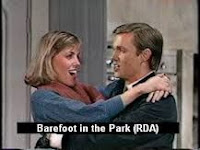A touring company of Barefoot
in the Park, starring Richard Thomas and Besss Armstrong as Paul and Paul
and Corie, was videotaped and televised on HBO in March of 1982.
None-too-coincidentally broadcast a week before Simon’s film You Ought to Be In Pictures, it
solidified the cable network’s nascent series “HBO Theater,” part of their move
to get beyond simply showing theatrical releases, a move that really gained
momentum with the following year’s release of The Terry Fox Story, the first made-for-HBO movie. I saw this
version of Barefoot later that year,
in July, when I successfully entreated my parents to sign up for HBO so long as
helped defray the “steep” monthly bill of nine dollars. My memory far too fuzzy
to write a decent review, I recently went to the online video tape trader
“Professor Video” to procure a copy. God bless the Internet!
I won’t reiterate the plot here; as the 1967 film was
pretty faithful, you can simply scroll to that review for a synopsis. The only
major difference involves Paul and Corie’s argument toward the end; the play
version is far longer, and more intense, at times reminding me of the harrowing
face off between George and Martha in – nearly all of – Who’s Afraid of Virgina Woolf? (Simon was probably wise to trim it
for the film.) And obviously in a stage version, you get a far greater
immediacy in the performances, as well as a sense of how an audience reacts to
Simon’s one-liners. The physical stuff about the Greek food was a favorite, abetted greatly by the added physicality that was not necessarily in the script.
As for the presentation itself, it’s pretty good, clearly a testament to Simon’s skills in their home format – live theater. At a running time of just over two hours, it moves briskly, enlivened by the dynamic chemistry between its two stars, Thomas and Armstrong. Thomas, of course, was well-known by this time from his career-making role of John-Boy Walton in The Waltons. But here he demonstrates a somewhat greater range – his ability to manage rom-com chemistry shows he can play more than just earnest, earnest and more earnest. And during his hair-raising argument, in which he practically becomes a Mr. Hyde to his heretofore Dr. Jekyll, the audience roars with frightful delight to see an actor not simply transcending the first two acts of the play but also the first twelve years of his career.
As for the presentation itself, it’s pretty good, clearly a testament to Simon’s skills in their home format – live theater. At a running time of just over two hours, it moves briskly, enlivened by the dynamic chemistry between its two stars, Thomas and Armstrong. Thomas, of course, was well-known by this time from his career-making role of John-Boy Walton in The Waltons. But here he demonstrates a somewhat greater range – his ability to manage rom-com chemistry shows he can play more than just earnest, earnest and more earnest. And during his hair-raising argument, in which he practically becomes a Mr. Hyde to his heretofore Dr. Jekyll, the audience roars with frightful delight to see an actor not simply transcending the first two acts of the play but also the first twelve years of his career.
But it’s really Armstrong who steals the show here,
advancing beyond the homewrecking ingénue she played in the previous year’s The Four Seasons. She has such a
disarming charm about her, balancing between the all-important line of free-spiritedness in the first act and acidic petulance in the
second – both characteristics masking latent feelings of insecurity about the
future of her potentially too-hasty marriage. Her job here is every equal to
Jane Fonda’s work from the movie adaptation, and, given how much I cherished
that version, that’s quite a compliment.
Only major complaint, and since this is a by-the-book
performance of the play, it would be the same critique I have for Mr. Simon himself
(perish the thought): the end is far too abrupt. Paul climbs out on the ledge,
drunk and self-pitying, prompting his wife to exhort her love for him. Then –
Bam! – curtain, and we can only assume she coaxed him down. The movie solved
this error with a cuddly denoumont on terra firma. But the stage version, as it
now plays, feels like the tape ran out about five minutes too early.
In any case, it’s a top-notch effort. Bravo!
Rating: ***1/2




No comments:
Post a Comment